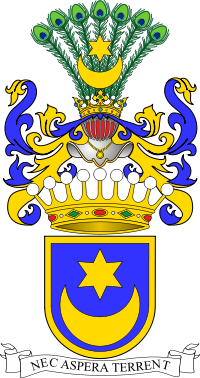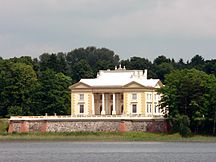Loading AI tools
Polish-Lithuanian magnate family From Wikipedia, the free encyclopedia
The House of Tyszkiewicz (Polish: Tyszkiewiczowie, singular: Tyszkiewicz, Belarusian: Тышкевічы, singular: Тышкевіч, Lithuanian: Tiškevičiai, singular: Tiškevičius, Ukrainian: Тишкевичі, singular: Тишкевич, Russian: Тышкевичи, singular: Тышкевич) was a wealthy and influential Polish-Lithuanian magnate family of Ruthenian origin, with roots traced to the times of the Grand Duchy of Lithuania. They held the Polish coat of arms Leliwa. Their nobility was reaffirmed in Polish–Lithuanian Commonwealth and the Russian Empire.
| Tyszkiewicz | |
|---|---|
 | |
| Current region | Lithuania, Poland, Ukraine, Belarus |
| Members | Ludwik Tyszkiewicz Teodor Tyszkiewicz Stefan Tyszkiewicz |
| Estate(s) | Tyszkiewicz Palace Tiškevičiai Palace Lentvaris Manor |
The family traces its roots to a 15th-century Ruthenian boyar Kalenik Mishkovich and derives from the name of his grandson, Tysha with the addition of the patronymic, resulting in Tyszkiewicz-Kalenicki. A branch of the family Germanised the name to Tischkowitz and a few members of this branch are still to be found in Germany and the UK.
Places named Tyszkiewicz Palace, "former Tyszkiewicz Palace", Tiškevičiai Palace, and other historical properties of the family are located in Warsaw, Kraków and Vilnius, as well as in numerous towns of modern Poland, Belarus, Lithuania and Ukraine (in Palanga, Kretinga, Lahojsk, Raudondvaris, Berdychiv, Biržai, Kavarskas, Deltuva, Trakai, Lentvaris, Seredžius, etc.)
 |
 |
 | ||
| Astravas Manor | Tiškevičiai Palace, Palanga | Užutrakis Manor on Lake Galvė, Trakai |
Palaces connected with the Tyszkiewicz family
Seamless Wikipedia browsing. On steroids.
Every time you click a link to Wikipedia, Wiktionary or Wikiquote in your browser's search results, it will show the modern Wikiwand interface.
Wikiwand extension is a five stars, simple, with minimum permission required to keep your browsing private, safe and transparent.